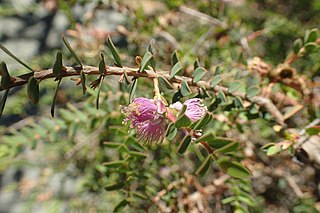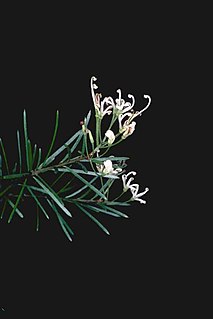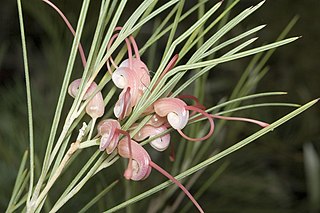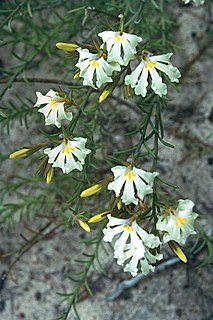
Banksia purdieana is a species of bushy shrub that is endemic to Western Australia. It has broadly linear, pinnatipartite leaves with sharply-pointed lobes on the sides, yellow flowers in heads of about eighty and egg-shaped follicles.

Grevillea excelsior, commonly known as flame grevillea or yellow flame grevillea, is a species of flowering plant in the family Proteaceae and is endemic to the south-west of Western Australia. It is an erect shrub or small tree with usually divided leaves with linear lobes, and clusters of orange flowers.

Grevillea asteriscosa, commonly known as star-leaf grevillea, is a species of flowering plant in the family Proteaceae and is endemic to the south-west of Western Australia. It is a shrub with widely-spreading branches, star-shaped leaves with sharply-pointed lobes, and bright red flowers.

Melaleuca depressa is a plant in the myrtle family, Myrtaceae and is endemic to the south-west of Western Australia. It is a small, bushy shrub with clusters of yellow or cream flowers on the ends of its branches in spring.

Melaleuca platycalyx is a plant in the myrtle family, Myrtaceae, and is endemic to the south-west of Western Australia. It is a small, twiggy shrub with short spikes of purple or pink flowers in spring. The distinguishing features of this species include petals that are bent downwards, an unusually large number of stamens in each flower and unusually large fruits arranged in alternating pairs.

Melaleuca psammophila is a plant in the myrtle family, Myrtaceae, and is endemic to the south-west of Western Australia. It is a small shrub with narrow leaves, heads of purple, pink or mauve flowers and clusters of woody fruit. It is similar to M. bisulcata but differs from that species in characters such as the shape of its fruit, leaves and buds but like that species is an attractive, profusely flowering shrub suitable for cultivation as a garden plant.

Melaleuca sclerophylla is a plant in the myrtle family, Myrtaceae, and is endemic to the south-west of Western Australia. It is distinguished by its unusual leaves which are rough, leathery and covered with small, warty lumps and by its many purple heads of flowers in early spring.

Isopogon alcicornis, commonly known as the elkhorn coneflower, is a plant in the family Proteaceae and is endemic to part of the South Coast Western Australia. It is a low shrub with pinnately-lobed leaves and oval heads of hairy, white or pink flowers.
Verticordia stenopetala is a flowering plant in the myrtle family, Myrtaceae and is endemic to the south-west of Western Australia. It is a low shrub with small leaves and heads of pink to magenta-coloured flowers in late spring and early summer.
Grevillea eremophila is a species of flowering plant in the family Proteaceae and is endemic to the south-west of Western Australia. It is an erect shrub with leathery, linear to narrowly egg-shaped leaves with the narrower end towards the base, and creamy-white flowers.

Grevillea inconspicua, commonly known as Cue grevillea, is a species of flowering plant in the family Proteaceae and is endemic to the central-west of Western Australia. It is a prickly, densely-branched shrub with linear leaves and clusters of off-white to silvery grey flowers.

Grevillea incrassata is a species of flowering plant in the family Proteaceae and is endemic to inland south-western Western Australia. It is an erect shrub with crowded cylindrical or narrowly linear leaves and clusters of bright yellow flowers.
Grevillea incurva is a species of flowering plant in the family Proteaceae and is endemic to inland south-western Western Australia. It is an erect shrub with linear adult leaves and clusters of creamy-yellow flowers.

Grevillea oncogyne is a species of flowering plant in the family Proteaceae and is endemic to inland areas of Western Australia. It is an erect to spreading shrub with linear, sometimes lobed leaves, and clusters of red or pinkish red flowers.
Baeckea elderiana is a species of flowering plant in the family Myrtaceae and is endemic to central Western Australia.
Goodenia eremophila is a species of flowering plant in the family Goodeniaceae and is endemic to inland areas of Western Australia. It is an ascending herb with linear to elliptic leaves and thyrses of blue flowers.

Daviesia dielsii, commonly known as Diels' daviesia, is a species of flowering plant in the family Fabaceae and is endemic to the south-west of Western Australia. It is on intricately-branched shrub with sharply-pointed, egg-shaped, vertically compressed phyllodes, and yellow and red flowers.
Lechenaultia juncea, commonly known as reed-like leschenaultia, is a species of flowering plant in the family Goodeniaceae and is endemic to the south-west of Western Australia. It is an erect, perennial herb or shrub with crowded, fleshy leaves, and pale blue flowers.
Grevillea ceratocarpa is a species of flowering plant in the family Proteaceae and is endemic to inland areas of the south-west of Western Australia. It is an erect or spreading shrub with softly-hairy, narrowly elliptic or narrowly egg-shaped leaves with the narrower end towards the base, and creamy-white flowers.

Lechenaultia stenosepala, commonly known as narrow-sepaled leschenaultia, is a species of flowering plant in the family Goodeniaceae and is endemic to the south-west of Western Australia. It is an open, more or less erect perennial herb or shrub with crowded, narrow leaves, and blue to pale blue or creamy-white flowers.















